
A lug wrench, also colloquially known as a tire iron , is the name for a type of socket wrench used to loosen and tighten lug nuts on automobile wheels. In the United Kingdom and Australia, it is commonly known as a wheel brace.

A lug wrench, also colloquially known as a tire iron , is the name for a type of socket wrench used to loosen and tighten lug nuts on automobile wheels. In the United Kingdom and Australia, it is commonly known as a wheel brace.
Lug wrenches may be L-shaped, or X-shaped. The form commonly found in car trunks is an L-shaped metal rod with a socket wrench on the bent end and a prying tip on the other end. The prying tip is mainly intended to remove hub caps or wheel covers that may be covering a wheel's lug nuts.
Another common type, sometimes called a spider wrench, is made in the shape of a cross with different sized sockets on each of the four ends. Other names are four way wheel wrench, spanner, brace, or cross.
This section possibly contains original research .(April 2021) |
Ideally, the nuts (or bolts) should be tightened with a torque wrench. Lug wrenches are much less expensive because they lack the ability to measure or limit the force used. Installing a wheel with a lug wrench thus requires a bit of rough guessing about proper tightness. Excessive force can strip threads or make the nuts very difficult to remove. Also, uneven torque between the various lug nuts, or excessive torque, can lead to warping of the brake rotor if the car is equipped with disc brakes. For this reason, impact wrenches should properly be used only for removing lug nuts, not for tightening them, although in practice this rule is often ignored for convenience's sake, even by professional mechanics.
When re-fitting a wheel, the nuts (or bolts) should be tightened in a criss-cross pattern (to even out the forces) and initially should only be tightened "finger tight" on all nuts. In this context "finger tight" is tight enough to reach the point where free play is taken up and proper tightening is about to begin, say, the tightening force using the lug wrench/wheel brace like a screwdriver. This should be repeated twice, to ensure the wheel is properly centered and restrained by all nuts (as often the first nut that is tightened will be slightly loose after completing the set for the first time), then the wheel should be lowered to the ground and the criss-cross tightening pattern repeated to modest torque (say few fingers force on the lug wrench/wheel brace arm), and then finally repeated to full hand force.

Rarely, and more often with large trucks and lorries, insufficient force can lead to the nuts coming undone while in use. Because of this, it is best to use a torque wrench or similar tool to finally tighten the wheel lug nuts to the proper torque specification as soon as possible after using a lug wrench to affix a wheel. At the very least, the lug nuts should be checked for tightness after 50–100 km/miles when things have been subject to some vibration and thermal cycling.
This tool also has a secondary usage: it can be used as a tool to remove vehicles that are stuck in snow.
A torque wrench is a tool used to apply a specific torque to a fastener such as a nut, bolt, or lag screw. It is usually in the form of a socket wrench with an indicating scale, or an internal mechanism which will indicate when a specified (adjustable) torque value has been reached during application.

Torx is a trademark for a type of screw drive characterized by a 6-point star-shaped pattern, developed in 1967 by Camcar Textron. A popular generic name for the drive is star, as in star screwdriver or star bits. The official generic name, standardized by the International Organization for Standardization as ISO 10664, is hexalobular internal. This is sometimes abbreviated in databases and catalogs as 6lobe. Torx Plus,Torx Paralobe and Torx ttap are improved head profiles.
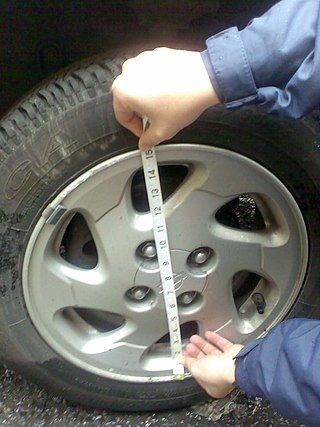
The wheel size for a motor vehicle or similar wheel has a number of parameters.

A bolted joint is one of the most common elements in construction and machine design. It consists of a male threaded fastener that captures and joins other parts, secured with a matching female screw thread. There are two main types of bolted joint designs: tension joints and shear joints.

A socket wrench is a type of spanner that uses a closed socket format, rather than a typical open wrench/spanner to turn a fastener, typically in the form of a nut or bolt.
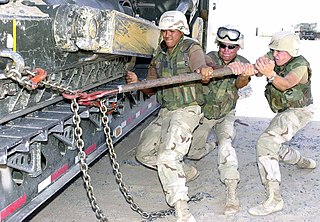
A cheater bar, snipe, or cheater pipe is an improvised breaker bar made from a length of pipe and a wrench (spanner).
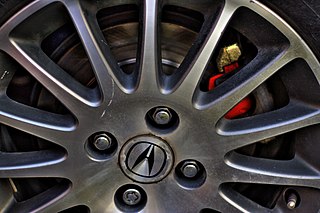
A lug nut or wheel nut is a fastener, specifically a nut, used to secure a wheel on a vehicle. Typically, lug nuts are found on automobiles, trucks (lorries), and other large vehicles using rubber tires.
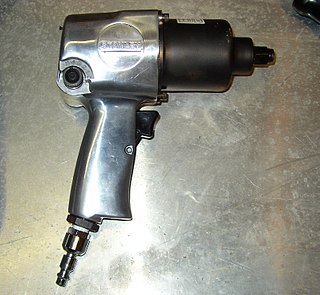
An impact wrench is a socket wrench power tool designed to deliver high torque output with minimal exertion by the user, by storing energy in a rotating mass, then delivering it suddenly to the output shaft. It was invented by Robert H. Pott of Evansville, Indiana.

An impact driver is a tool that delivers a strong, sudden rotational force and forward thrust. The force can be delivered either by striking with a hammer in the case of manual impact drivers, or mechanically in the case of powered impact drivers.

A peanut butter wrench, also known as a crank bolt spanner or a crank spanner, is a single-ended box wrench or ring spanner used in cycling to tighten older 14 mm and 15 mm crank bolts, or the wheel nuts on hubs with solid axles commonly found on track bicycles, particularly the 15 mm wrench made by Campagnolo. This is the only one-piece wrench that can be used to tighten or loosen the bolt or nut which holds the crank to a square-taper bottom bracket spindle, whereas any wrench/spanner of the correct size will tighten or loosen wheel nuts.

Wheel studs are the threaded fasteners that hold on the wheels of many automobiles. They are semi-permanently mounted directly to the vehicle hub, usually through the brake drum or brake disk. Lug nuts are fastened onto the wheel stud to secure the wheel. When a wheel is removed for tire changes etc., the stud remains in the hub.
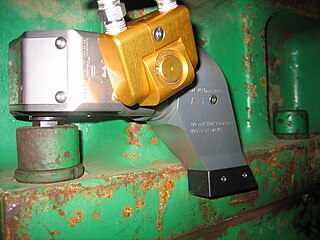
A hydraulic torque wrench is a power tool designed to exert torque on a fastener to achieve proper tightening or loosening of a connection through the use of hydraulics. A torque wrench is applied to the nut either directly or in conjunction with an impact socket. Hydraulic torque wrenches apply a predetermined, controlled amount of torque to a properly lubricated fastener.
Multi-jackbolt tensioners (MJT) are an alternative to traditional bolted joints. Rather than needing to tighten one large bolt, MJTs use several smaller jackbolts to significantly reduce the torque required to attain a certain preload. MJTs range in thread sizes from 3⁄4 in (19 mm) to 32 in (810 mm) and can achieve 20 million pounds-force or more. MJTs only require hand-held tools, such as torque wrenches or air/electric impacts, for loading and unloading bolted joints.

A nut is a type of fastener with a threaded hole. Nuts are almost always used in conjunction with a mating bolt to fasten multiple parts together. The two partners are kept together by a combination of their threads' friction, a slight stretching of the bolt, and compression of the parts to be held together.
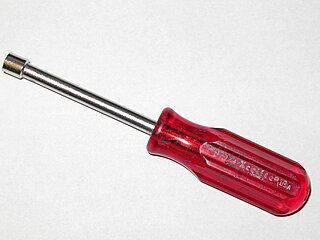
A nutdriver or nut driver is a hand tool for tightening or loosening nuts and bolts. It essentially consists of a socket attached to a shaft and cylindrical handle and is similar in appearance and use to a screwdriver. They generally have a hollow shaft to accommodate a shank onto which a nut is threaded. They are typically used for lower torque applications than wrenches or ratchets and are frequently used in the appliance repair and electronics industries.

A bolt is an externally helical threaded fastener that fastens objects with unthreaded holes together. This is done by applying a twisting force (torque) to a matching nut. The bolt has an external male thread requiring a matching nut with a pre-formed female thread. Unlike a screw, which holds objects together by the restricting motion parallel to the axis of the screw via the normal and frictional forces between the screw's external threads and the internal threads in the objects to be fastened, a bolt prevents that linear motion via the frictional and normal forces between the bolt's external threads and the internal threads of the matching nut, which can be tightened by applying a torque which moves the nut linearly along the axis of the bolt and compresses the objects to be fastened.
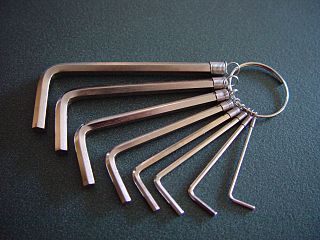
A hex key is a simple driver for bolts or screws that have heads with internal hexagonal recesses (sockets).

Width across flats is the distance between two parallel surfaces on the head of a screw or bolt, or a nut, mostly for torque transmission by positive locking.
A centerlock wheel is a type of automobile wheel in which the wheel is fastened to the axle using a single, central nut, instead of the more common ring of 4 or 5 lug nuts or bolts.